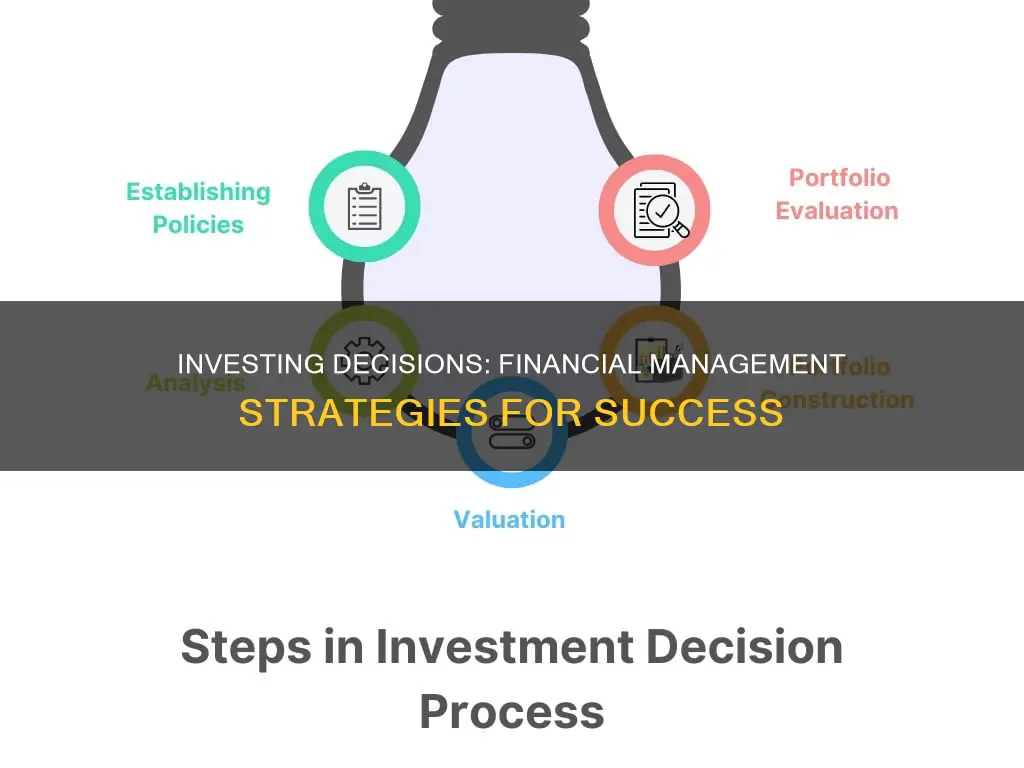
Making an investment decision is a crucial aspect of financial management. Financial managers are tasked with making decisions about how to best utilise a company's financial resources to achieve its objectives. There are typically three primary types of financial decisions that managers must make: investment decisions, financing decisions, and dividend decisions. These decisions involve evaluating and selecting investment opportunities, determining the optimal financing mix, and deciding on the distribution of profits among shareholders.
Investment decisions can be long-term or short-term and involve assessing the risk, cost of capital, and expected benefits of potential investments. Financing decisions relate to the amount of finance to be raised from various sources, such as equity, debt, or a combination of both. Dividend decisions consider how much profit to distribute to shareholders and how much to retain for future investments or contingencies.
Ultimately, these financial decisions are interrelated and aim to maximise shareholder wealth while effectively managing the company's assets, capital structure, and financial risks.
| Characteristics | Values |
|---|---|
| Investment decisions | Long-term and short-term |
| Financing decisions | Capital structure, cost of raising funds, risk, cash flow position, control considerations, market conditions |
| Dividend decisions | Distribution of profits, earnings, stability of dividends, growth opportunities, cash flow positions, shareholders' preferences, taxation policy, stock market reactions, access to capital markets, legal and contractual constraints |
| Working capital management decisions | Management of current assets and liabilities, optimum level of working capital, sources of raising short-term funds, credit policy, ratio of cash and credit sales, management of cash, administration of bills receivables and payables, investment of surplus cash |
What You'll Learn

Evaluate the risk
Evaluating the risk is a crucial aspect of financial management and investment decision-making. When assessing the risk associated with an investment, it's important to consider the following factors:
Risk Tolerance and Comfort Zone
Understanding your risk tolerance and comfort zone is essential. All investments carry some level of risk, and it's important to be aware that you could lose some or all of your money. Stocks, bonds, and mutual funds typically do not offer federal insurance on your investments, so you need to be comfortable with the potential for loss.
Risk and Return Trade-Off
The relationship between risk and return is crucial. Higher-risk investments, such as stocks or bonds, tend to offer the potential for greater returns over time. On the other hand, lower-risk investments, like cash equivalents, may be more suitable for short-term financial goals, although they carry the risk of inflation eroding returns.
Diversification and Asset Allocation
Diversifying your investments across different asset classes, such as stocks, bonds, and cash, can help manage risk. By investing in multiple assets, you reduce the impact of losses in one area and smoothen your overall investment journey.
Cost of Raising Funds
The cost of raising funds from different sources varies significantly. When evaluating investment options, consider the cheapest source of finance that aligns with your risk tolerance. Borrowed funds, for example, tend to be riskier than equity funds and may have higher associated costs.
Market Conditions
The state of the market plays a crucial role in investment decisions. During boom periods, equity issuance is more common, while debt financing is typically utilized during depressions. Consider the current market conditions and their potential impact on your investment choices.
Cash Flow Position
A company's cash flow position refers to its regular day-to-day earnings. A strong cash flow position gives investors confidence and encourages them to invest funds in the company. Conversely, a weak cash flow position may discourage investors.
Control Considerations
Existing investors who want to maintain control of the business may choose to raise funds through borrowing. However, if they are willing to dilute control, equity can be utilized to raise capital. Deciding how much control to relinquish is a significant aspect of financial decision-making.
Flotation Costs
Flotation costs refer to the expenses incurred when issuing securities, such as broker commissions and underwriting fees. Higher flotation costs make a source of finance less attractive, as they reduce the overall return on investment.
Growth Opportunities
Companies with strong growth prospects may opt to retain more profits to finance their expansion plans. As a result, they may declare lower dividends or none at all.
Taxation Policy
The taxation policy can influence dividend decisions. If the tax rate on dividends is high, companies may prefer to pay lower dividends to reduce their tax liability. Conversely, a lower tax rate on dividends may encourage companies to distribute more profits as dividends.
Credit Risk
When investing in securities, there is a risk of default on the payment of periodical interest and the repayment of capital. This credit risk, also known as financial risk, is an essential factor to consider when evaluating the risk associated with an investment.
Savings and Investments: Your Guide to Financial Freedom
You may want to see also

Assess the investment mix
When assessing the investment mix, it is important to consider the following factors:
Risk Tolerance
Understanding your risk tolerance is crucial before investing. All investments carry some level of risk, and it's important to recognise that you could lose some or all of your money. The potential for greater returns increases with riskier investments, such as stocks or bonds, but these also carry a higher chance of loss. On the other hand, short-term financial goals may be better suited to less risky investments, such as cash equivalents, which carry the risk of inflation eroding returns over time.
Diversification
Diversifying your investments across different asset categories, such as stocks, bonds, and cash, can help protect against significant losses. Historically, these asset categories have not moved in sync, so investing in multiple categories can reduce the overall risk and smooth out returns. This strategy, known as asset allocation, is crucial for long-term financial goals, such as retirement planning, and can be achieved through mutual funds or lifecycle funds.
Emergency Funds
It is wise to set aside an emergency fund before investing heavily. This ensures that you have a safety net in case of sudden unemployment or other financial setbacks. Aim to save enough to cover at least six months' worth of expenses.
Credit Card Debt
High-interest credit card debt should be prioritised for repayment before investing. Paying off these debts is often a safer and more profitable strategy than risking your money in the market.
Dollar Cost Averaging
Consider the investment strategy of dollar cost averaging, which involves investing a fixed amount regularly over a long period. This approach helps to mitigate the risk of investing a large sum at an inopportune time by buying more when prices are low and less when prices are high.
Employer Benefits
Take advantage of any employer-sponsored retirement plans, such as 401(k) matches, as this is essentially "free money" for your retirement savings.
Portfolio Rebalancing
Occasionally review and rebalance your investment portfolio to maintain your desired asset allocation and risk level. This may involve buying or selling assets to return to your original investment strategy, and it can be done at regular intervals or when certain assets deviate from your desired allocation.
Vanguard's Investment Manager Selection: The Key Criteria
You may want to see also

Understand the company's dividend policy
Understanding a company's dividend policy is crucial when making investment decisions. A company's dividend policy outlines the method and frequency of dividend payouts to shareholders. Dividends are essentially a share of the company's profits distributed to shareholders, reflecting the return on their investment. When a company makes a profit, it can either retain the profits or distribute them to shareholders as dividends. This decision is made by the board of directors, taking into account various factors, such as growth prospects and future projects.
There are several types of dividend policies that companies may adopt:
- Regular dividend policy: Companies with this policy pay out dividends to shareholders annually. Even if the company makes abnormally high profits, the excess is withheld as retained earnings. Conversely, if the company incurs a loss, shareholders still receive a dividend. This policy is often used by companies with stable earnings and steady cash flow, making them low-risk investments.
- Stable dividend policy: Under this policy, the company sets a fixed percentage of profits to be paid out as dividends, regardless of the total profits for the financial year. For example, a company may set a payout rate of 6%, which will be paid out whether the company makes $1 million or $100,000. Investing in companies with this policy can be risky for investors, as the dividend amount fluctuates with profit levels, creating uncertainty.
- Irregular dividend policy: With this policy, the company is under no obligation to pay dividends, and the board of directors can decide how to utilise the profits. They may choose to distribute abnormal profits to shareholders or retain them for business expansion and future projects. Companies that lack steady cash flow or liquidity often adopt this policy. Investing in such companies carries a high risk for investors, as there is no guarantee of receiving dividends during the financial year.
- No dividend policy: Companies with this policy reinvest all profits back into the business for future growth. These companies are typically characterised by constant growth and expansion, and shareholders invest in them due to the appreciation of the company's stock value over time. For these investors, share price appreciation is more valuable than receiving dividend payouts.
When evaluating a company's dividend policy, it is essential to consider factors such as the company's growth prospects, stability of earnings, and the type of investors they aim to attract. Dividend policies play a significant role in investment decisions, as they indicate a company's financial performance and can help investors earn high returns on their investments.
Taxable Investment Portfolio: Diversification Strategies for Long-Term Growth
You may want to see also

Manage assets
Asset management is a critical aspect of financial management, ensuring a company's ability to meet its obligations and objectives. Effective management of assets can be broken down into several key areas:
- Market Study and Objective Clarity: Before making any investment decisions, it is crucial to conduct a thorough market study and clearly understand the company's objectives. This includes analysing demand, technology, equipment, financing methods, and human resources available.
- Resource Adaptation: Evaluating whether the company's resources align with its desired size and structure. If there is a misalignment, the financial manager must determine what types of assets the company should acquire or dispose of to achieve efficient management.
- Current Asset Management: Prioritising the management of current assets, such as accounts receivable and inventories, over fixed assets. Current assets are essential for the company's near-term operations and can be quickly converted into cash without losing value.
- Fixed Asset Management: While not as liquid as current assets, fixed assets like offices, warehouses, machinery, and vehicles are necessary for permanent operations. Financial managers must balance the management of these assets to maintain efficient operations.
- Optimal Financing Mix: Determining the right mix of short-term and long-term financing options to support the company's investment and financial strategy objectives. This may involve a combination of debt and equity financing to optimise cost and risk.
By effectively managing these aspects, financial managers can ensure that a company's assets are utilised efficiently and aligned with its strategic goals. This, in turn, contributes to the overall financial health and success of the organisation.
Fisher Investments: Understanding the Half-Million Portfolio Strategy
You may want to see also

Consider the financing strategy
Financing decisions are concerned with the borrowing and allocating of funds required for a firm's investment decisions. They are also known as capital budgeting decisions. A company's assets and resources are limited and must be utilised effectively.
There are two sources of funds:
- Capital owned by the business, including shareholding and retained earnings.
- Funds borrowed from outside the corporate entity in the form of debentures, loans, bonds, etc.
The financing decision is based on these two sources of funds and aims to achieve an optimal capital structure. It is a crucial decision that determines the borrowing and allocating of funds for the firm's investment plans.
When defining a financing strategy, it is essential to consider the following:
- Study the sources willing to offer credit to the organisation and define the best financing options for operations.
- Design a mixed financing strategy, also known as the company's "financing mix". This may involve a combination of short and long-term financing to meet investment and financial strategy objectives.
- Evaluate the cost of raising funds from various sources and select the most cost-efficient option.
- Assess the risk associated with different sources of funding. Borrowed funds, for example, carry more risk than equity funds.
- Consider the cash flow position of the business. A strong cash flow position encourages investors to invest in the company.
- Evaluate control considerations. If existing investors want to maintain control of the business, financing can be achieved through borrowing. However, if they are willing to dilute control, equity can be used to raise funds.
- Take into account the state of the capital markets. During a boom period, equity is predominantly issued, while debt is utilised during a depression.
The financing strategy is a critical aspect of financial management, and it plays a vital role in ensuring the continuity of the business over the long term. It involves addressing questions such as how much capital is needed to fund the firm's operations and determining the optimal mix of financing for these investment proposals.
Invest or Save? Where Should Your Money Go?
You may want to see also







